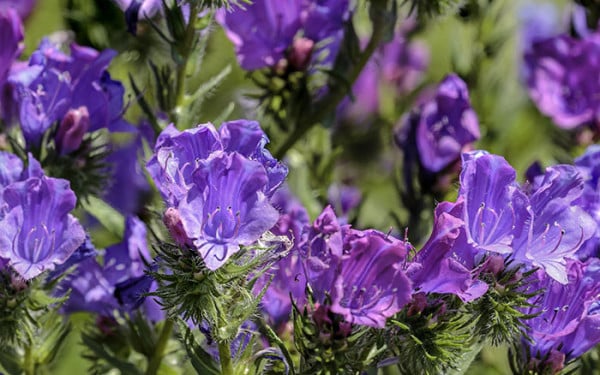Relaxed coastal gardens are known for their silvery foliage, grassy greens, and bright flowers. The plants are full of colour, texture, and movement, and they bring a sense of wilderness and freedom.
You don’t need sea views to get that fun, informal look in your own outdoor space. Most coastal plants will thrive in any garden with well-drained soil and a sunny spot. They are tough plants, used to battling strong winds and salty air, usually in poor soil or on steep banks.
It’s fantastic to get that seaside flavour, especially when you live miles away from the nearest coast. So, I’ve picked the top 10 coastal plants to bring the beach to you.
Echium vulgare (viper’s bugloss)
This tall plant has lovely upright spikes of tiny purple flowers, often with bright stamen. The bees and pollinators love it and it also self-seeds, so it’s really low maintenance.
• Sun – Full sun
• Position – South, North, East or West-facing
• Exposure – Exposed or sheltered
• Moisture – Well-drained
• Soil – Loam, chalk, or sand

Rosmarinus officinalis (rosemary)
A woody Mediterranean herb is perfect for a seaside spot, and this one is incredibly hardy. It is an evergreen with delicate violet-blue flowers in the summer, and it smells divine so planting it near paths and doorways means you can make the most of the aroma.
• Sun – Full sun
• Position – South, West or East-facing
• Exposure – Sheltered or exposed
• Moisture – Well-drained or moist but well-drained
• Soil – Sand, clay, chalk, or loam

Eryngium variifolium (variable-leaved sea holly)
The striking silver foliage and architectural blooms with prickly cone-like heads will add some texture to your softer spaces. It copes in sandy soils, which are common in seaside gardens.
• Sun – Full sun
• Position – South, West or East-facing
• Exposure – Exposed
• Moisture – Well-drained
• Soil – Sand, chalk, or loam

Armeria maritima (thrift)
A robust, low-growing plant will look brilliant at the front of borders or lining pathways. Thrift is an evergreen that blooms pink pom-pom flowers throughout summer. Add it to a rock garden to bring so colour to the dry, sunny spot.
• Sun – Full sun
• Position – South, North, West or East-facing
• Exposure – Exposed or sheltered
• Moisture – Well-drained
• Soil – Chalk, clay, sand, or loam

Crambe maritima (sea kale)
For some classic seaside charm, this is a great foliage plant with its wrinkled silvery-green leaves, which his even edible like other kale. It does die down over winter, but it regrows fresh and green in spring. In early summer, small white flowers bloom, which are popular with pollinators.
• Sun – Full sun or partial shade
• Position – South, East or West-facing
• Exposure – Sheltered
• Moisture – Well-drained
• Soil – Sand, clay, chalk, or loam

Erigeron glaucus ‘Sea Breeze’ (fleabane)
A long-flowering plant with sunny daisy-like blooms with rich blue-grey-green foliage. As a self-seeder, it will fill cracks and crevices in any free-draining soil. Butterflies love it too.
• Sun – Full sun
• Position – South or West facing
• Exposure – Exposed or sheltered
• Moisture – Moist but well-drained
• Soil – Loam, chalk, or sand

Limonium platyphyllum (broad-leaved statice)
Limonium is a very hardy plant, and in summer blooms sprays of tiny, pink-purple delicate-looking flowers. Useful in dry and stony spots, so will fit well into a gravel garden.
• Sun – Full sun
• Position – South-facing
• Exposure – Exposed or sheltered
• Moisture – Well-drained
• Soil – Loam, chalk, or sand

Cordyline australis (cabbage palm)
Cordyline is a striking evergreen architectural plant that has the appearance of a small palm tree to add an exotic atmosphere to a coastal-style garden. In summer large panicles of small cream flowers bloom that are joined by an aroma.
• Sun – Full sun or partial shade
• Position – South or West-facing
• Exposure – Sheltered
• Moisture – Well-drained or moist but well-drained
• Soil – Chalk, clay, sand, or loam

Festuca glauca ‘Elijah Blue’ (blue fescue)
A seaside garden isn’t complete without some soft grass texture to blow in the breeze. Festuca is an evergreen that is happy in containers, and rockeries, and can add texture to flowerbeds. When clumps are planted separately among gravel and pebbles, it can have a striking impact.
• Sun – Full sun
• Position – South, West or East-facing
• Exposure – Exposed or sheltered
• Moisture – Well-drained or moist but well-drained
• Soil – Loam, chalk, or sand

Verbascum ‘Gainsborough’ (mullein)
Muellin’s fluffy silvery leaves and yellow flower spikes tower in flowerbeds where they grow to 1.5 metres. If you want to propagate, these aren’t self-seeders, so you’ll need to propagate by root cuttings.
• Sun – Full sun
• Position – South-facing
• Exposure – Exposed
• Moisture – Well-drained
• Soil – Loam or chalk

By mixing shapes, colours, and textures in your borders, it will add to the coastal effect. Add to the look with gravel, shells, pebbles, and driftwood. You could even add in some big props like a boat and create a fun play area with a sandpit for the kids to enjoy.

Hopefully I will get my garden like all the Love your garden programmes ideas love all these plants to